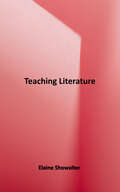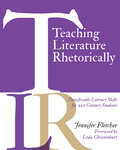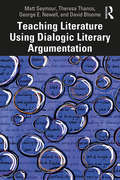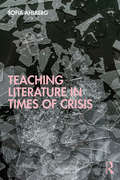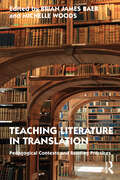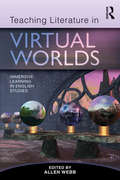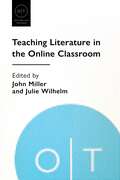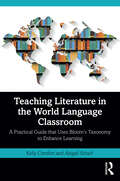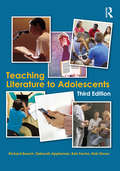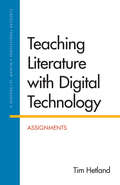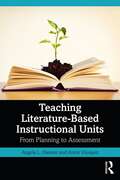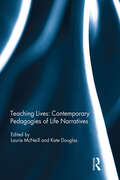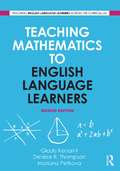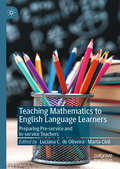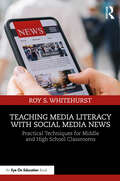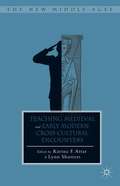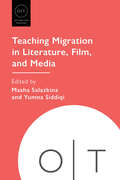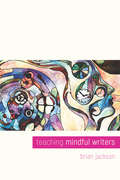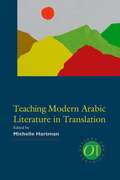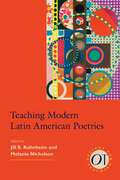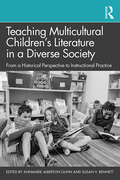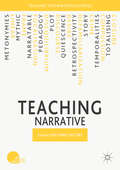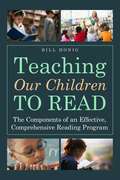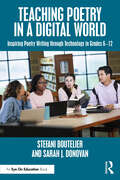- Table View
- List View
Teaching Literature
by Elaine ShowalterThis book is an inspirational guidebook for all English and American literature teachers in higher education. - Written by leading academic, prolific author, and cultural journalist, Elaine Showalter - Original and provocative reflections on teaching literature in higher education - Encourages teachers to make their classroom practice intellectually exciting - Wide-ranging - covers the practical, theoretical, and methodological aspects of teaching literature - Highly practical - employs real examples from real classes and careers throughout - Draws on 40 years of international teaching experience
Teaching Literature Rhetorically: Transferable Literacy Skills for 21st Century Students
by Jennifer FletcherEnglish language arts teachers often find themselves defending their discipline and the practical values it has. When will I read this again? is an all too common question heard in classrooms. Author Jennifer Fletcher faced the same questions and more. In Teaching Literature Rhetorically: Transferable Literacy Skills for 21st Century Students she shows you how to help your students develop transferable literacy skills that allow them to succeed not just in their English language arts classes, but in their future lives and careers. The book is built around eight high-utility literacy skills and practices that will help students communicate effectively and with confidence as they navigate important transitions in their lives: Integrating skills and knowledge from texts Reading closely and critically Assessing rhetorical situations Negotiating different perspectives Developing and supporting a line of reasoning Analyzing genres Communicating with self and others in mind Reading and writing with passion Teaching Literature Rhetorically offers readers writing prompts, readings, discussion questions, graphic organizers, as well as examples of student work and activities for helping students to understand key rhetorical concepts. As Fletcher writes in her introduction rhetorical thinking promotes the transfer of learning — the single most important goal we can have as teachers if we hope to have a positive impact on our students&’ lives. This book will help teachers everywhere do just that.
Teaching Literature Using Dialogic Literary Argumentation
by George E. Newell David Bloome Matt Seymour Theresa ThanosIntroducing a new framework for teaching and learning literature in secondary schools, this book presents Dialogic Literary Argumentation as an inquiry-based approach to engage students in communicating and exploring ideas about literature. As a process of discovery, Dialogic Literary Argumentation facilitates conversation—"arguing-to-learn"—as a method to support students’ diverse perspectives and engagement with one another in order to develop individual and collective understandings of literature and their place in the world. Covering both the theoretical foundation and application of this method, this book demonstrates how to apply Dialogic Literary Argumentation to teach literature in a way that foregrounds dialogue, learning through inquiry, diverse views, listening to others, and engagement with our communities. Ideal for preservice teachers in literacy methods courses and practicing teachers, it features real-world cases, discussions of the principles presented, resource lists, and conversation starters for professional learning communities, professional development, and teacher education.
Teaching Literature in Times of Crisis
by Sofia AhlbergTeaching Literature in Times of Crisis looks at the range of different crises currently affecting students – from climate change and systemic racism, to the global pandemic. Addressing the impact on students’ ability and motivation to learn as well as their emotional wellbeing, this volume guides teachers toward strategies for introducing both canonical and contemporary literature in ways that demonstrate the future relevance of sophisticated and targeted literacy skills. These reading practices are invaluable for framing and critically examining the challenges associated with crisis in order to help cope with grief and as a means to impart the skills needed to deal with crisis, such as adaptability, flexibility, resilience, and resistance. Providing necessary background theory, alongside practical case studies, the book addresses: Reading practices for demonstrating how literature explores ethical issues in specific and concrete rather than abstract terms Making connections between disparate phenomena, and how literature mobilises affect in individual and collective human lives Supporting teachers in considering new, imaginative ways students can learn from literary content and form in online or remote learning environments as well as face to face Combining close and distant reading with creative and hands-on strategies, presenting the principles of a transitional pedagogy for a world in flux. This book introduces teachers to methods for reading and studying literature with the aim of strengthening and promoting resilience and resourcefulness in and out of the literature classroom and empower students as global citizens with local roles to play.
Teaching Literature in Translation: Pedagogical Contexts and Reading Practices
by Brian James BaerThe teaching of texts in translation has become an increasingly common practice, but so too has the teaching of texts from languages and cultures with which the instructor may have little or no familiarity. The authors in this volume present a variety of pedagogical approaches to promote translation literacy and to address the distinct phenomenology of translated texts. The approaches set forward in this volume address the nature of the translator’s task and how texts travel across linguistic and cultural boundaries in translation, including how they are packaged for new audiences, with the aim of fostering critical reading practices that focus on translations as translations. The organizing principle of the book is the specific pedagogical contexts in which translated texts are being used, such as courses on a single work, survey courses on a single national literature or a single author, and courses on world literature. Examples are provided from the widest possible variety of world languages and literary traditions, as well as modes of writing (prose, poetry, drama, film, and religious and historical texts) with the aim that many of the pedagogical approaches and strategies can be easily adapted for use with other works and traditions. An introductory section by the editors, Brian James Baer and Michelle Woods, sets the theoretical stage for the volume. Written and edited by authorities in the field of literature and translation, this book is an essential manual for all instructors and lecturers in world and comparative literature and literary translation.
Teaching Literature in Virtual Worlds: Immersive Learning in English Studies
by Allen WebbWhat are the realities and possibilities of utilizing on-line virtual worlds as teaching tools for specific literary works? Through engaging and surprising stories from classrooms where virtual worlds are in use, this book invites readers to understand and participate in this emerging and valuable pedagogy. It examines the experience of high school and college literature teachers involved in a pioneering project to develop virtual worlds for literary study, detailing how they created, utilized, and researched different immersive and interactive virtual reality environments to support the teaching of a wide range of literary works. Readers see how students role-play as literary characters, extending and altering character conduct in purposeful ways ,and how they explore on-line, interactive literature maps, museums, archives, and game worlds to analyze the impact of historical and cultural setting, language, and dialogue on literary characters and events. This book breaks exciting ground, offering insights, pedagogical suggestions, and ways for readers to consider the future of this innovative approach to teaching literary texts.
Teaching Literature in the Online Classroom (Options for Teaching #59)
by John Miller and Julie WilhelmThis volume considers the challenges and opportunities of online literature classes and suggests instructional strategies that ensure students are engaged in the virtual classroom. The ideas shared here are grounded in research, practice, critical self-reflection, and collaboration. Reflecting a diverse collection of practical tips and experiences from colleagues teaching at a variety of institutions, the essays offer readers the chance to inhabit others' classrooms. Contributors discuss building an interactive and inclusive classroom and using hypertext, video lectures, and other asynchronous and synchronous tools in classes whose subjects include, among others, Shakespeare, the Chinese novel, early American literature, speculative fiction, and contemporary American poetry.
Teaching Literature in the World Language Classroom: A Practical Guide that Uses Bloom’s Taxonomy to Enhance Learning
by Kelly Comfort Abigail ScharfTeaching Literature in the World Language Classroom presents a five-stage methodology for teaching literature in language curriculum that repurposes Bloom’s original and revised taxonomy to promote the language acquisition process and spark other types of learning. The first step of text selection, preparation, and initiation asks students to: recognize familiar words, structures, and concepts; contextualize the reading; and remember the main details of the text. The second stage of beginning literary analysis gets target-language learners to describe, identify, and understand the basic elements of plot, character, setting, and narration. The third phase of intermediate literary analysis prompts students to interpret, analyze, and examine major themes, key passages, and the overall commentary. The fourth step of advanced literary analysis teaches students to synthesize multiple and conflicting interpretations, compare assigned texts across units or themes, and evaluate works through essay writing. The fifth stage of reflective and creative engagement challenges students to relate the assigned texts to themselves through personal and intercultural reflection, create new artistic works, and produce unique texts in the target language. The concluding chapter showcases all five stages of the methodology by applying them to a sample text, thereby inviting world language educators to assess the potential usefulness of Comfort and Scharf’s approach to their own language courses. This is an ideal resource for world language educators teaching literature as well as undergraduate and graduate education students focusing on target-language literature instruction and its role in the language acquisition process.
Teaching Literature to Adolescents
by Deborah Appleman Rob Simon Richard Beach Bob FechoThis popular textbook introduces prospective and practicing English teachers to current methods of teaching literature in middle and high school classrooms. It underscores the value of providing students with a range of different critical approaches and tools for interpreting texts and the need to organize literature instruction around topics and issues of interest to them. Throughout the textbook, readers are encouraged to raise and explore inquiry-based questions in response to authentic dilemmas and issues they face in the critical literature classroom. New in this edition, the text shows how these approaches to fostering responses to literature also work as rich tools to address the Common Core English Language Arts Standards. Each chapter is organized around specific questions that English educators often hear in working with pre-service teachers. Suggested pedagogical methods are modelled by inviting readers to interact with the book through critical-inquiry methods for responding to texts. Readers are engaged in considering authentic dilemmas and issues facing literature teachers through inquiry-based responses to authentic case narratives. A Companion Website [http://teachingliterature.pbworks.com] provides resources and enrichment activities, inviting teachers to consider important issues in the context of their current or future classrooms.
Teaching Literature with Digital Technology Assignments
by Tim HetlandTeaching Literature with Digital Technology is a collection of digital assignments, each created by a contributor in the fields of literature and composition. Edited by Seattle-based scholar and teacher Tim Hetland and available as a print text or PDF e-book, this resource for instructors invites students to become knowledge-makers as it introduces creative uses of social media, digital tools, podcasts, multimodal assignments, and digital archives to learn about literature. Sample assignments can be viewed in the Professional Resources folder on the Macmillan English Community site. To order the print text, use ISBN: 978-1-4576-2948-8; to order a PDF e-book of the text, use ISBN: 978-1-3190-7643-6.
Teaching Literature-Based Instructional Units: From Planning to Assessment
by Anete Vásquez Angela L. HansenTeaching Literature-Based Instructional Units: From Planning to Assessment provides an accessible roadmap to planning, designing, and implementing literature-based instructional units for the English Language arts (ELA) classroom. Understanding that unit plans are the building blocks of the ELA curriculum, Hansen and Vásquez outline the theoretical foundations and approaches behind teaching ELA and offer a framework to help readers make sound decisions about their content pedagogy. In so doing, this text offers research-based and straightforward guidance on planning instruction around key literary texts. Placing literature at the center of the ELA curriculum, the approaches in this book not only support students’ reading, writing, listening, speaking, and digital media skills, but will also motivate and inspire them. Part 1 addresses how to choose unit themes and texts, discusses the importance of having a rationale for choices made, and examines the practical, philosophical, and historical approaches to teaching literature. Part 2 provides step-by-step instructions for designing literature-based units of instruction by using backwards design. The text focuses on assessment before moving into how to scaffold and sequence lessons to meet learning objectives, and concludes with consideration given to teaching ELA in virtual environments. The wealth of activities, strategies, exercises, examples, and templates in this book make this text essential reading for instructors and pre-service teachers in ELA pedagogical methods courses and for practicing teachers of literature instruction.
Teaching Lives: Contemporary Pedagogies of Life Narratives
by Kate Douglas Laurie McNeillThe contemporary ‘boom’ in the publication and consumption of auto/biographical representation has made life narratives a popular and compelling subject for twenty-first century classrooms. The proliferation of forms, media, terminologies, and disciplinary approaches in a range of educational contexts invites discussion of how and why we teach these materials. Drawing on their experiences in disciplines including creative writing, language studies, education, literary studies, linguistics, and psychology, contributors to this volume explore some of the central issues that inspire, enable, and complicate the teaching of life writing subjects and texts, examining the ideologies, issues, methods, and practices that underpin contemporary pedagogies of auto/biography. The collection acknowledges the potential perils that life writing texts and subjects represent for instructors, with a series of short essays by leading auto/biography scholars who reflect on their failed experiences teaching life narratives, and share strategies for negotiating the particular challenges these texts can present. Exploring issues including teaching across genres, analyzing writing about trauma, decolonizing pedagogies, and challenging assumptions (our own, our students’, and our colleagues’), Teaching Lives illuminates what makes the teaching of life narratives different from teaching other kinds of subjects or texts, and why auto/biography has such a critical role to play in contemporary education. This book was originally published as a special issue of a/b: Auto/Biography Studies.
Teaching Mathematics to English Language Learners
by Denisse R. Thompson Gladis Kersaint Mariana PetkovaToday's mathematics classrooms increasingly include students for whom English is a second language. Teaching Mathematics to English Language Learners provides readers a comprehensive understanding of both the challenges that face English language learners (ELLs) and ways in which educators might address them in the secondary mathematics classroom. Framed by a research perspective, Teaching Mathematics to English Language Learners presents practical instructional strategies for engaging learners that can be incorporated as a regular part of instruction. The authors offer context-specific strategies for everything from facilitating classroom discussions with all students, to reading and interpreting math textbooks, to tackling word problems. A fully annotated list of math web and print resources completes the volume, making this a valuable reference to help mathematics teachers meet the challenges of including all learners in effective instruction. Features and updates to this new edition include: An updated and streamlined Part 1 provides an essential overview of ELL theory in a mathematics specific context. Additional practical examples of mathematics problems and exercises make turning theory into practice easy when teaching ELLs New pedagogical elements in Part 3 include tips on harnessing new technologies, discussion questions and reflection points. New coverage of the Common Core State Standards, as well as updates to the web and print resources in Part 4.
Teaching Mathematics to English Language Learners: Preparing Pre-service and In-service Teachers (English Language Education Ser. #17)
by Luciana C. de Oliveira Marta CivilThis edited book is about preparing pre-service and in-service teachers to teach secondary-level mathematics to English Language Learners (ELLs) in twenty-first century classrooms. Chapter topics are grounded in both research and practice, addressing a range of timely topics including the current state of ELL education in the secondary mathematics classroom, approaches to leveraging the talents and strengths of bilingual students in heterogeneous classrooms, best practices in teaching mathematics to multilingual students, and ways to infuse the secondary mathematics teacher preparation curriculum with ELL pedagogy. This book will appeal to all teachers of ELLs, teacher educators and researchers of language acquisition more broadly. This volume is part of a set of four edited books focused on teaching the key content areas to English language learners. The other books in the set focus on teaching History and Social Studies, English Language Arts, and Science to ELLs.
Teaching Media Literacy with Social Media News: Practical Techniques for Middle and High School Classrooms
by Roy S. WhitehurstFeaturing tools, activities, and insightful stories from a CIA analyst and instructor with 30+ years’ of experience, this practical and engaging book supports busy educators to teach the lifelong skills of news and media literacy to their students.Based on existing curriculum and teaching standards, this guidebook shows how social studies and English language arts (ELA) teachers can build students’ confidence with social media evaluation skills, which are critical to engaging in civic discourse and building a stronger democracy. In Part 1, Whitehurst gives an overview of the media evaluation techniques based on those you would learn as a CIA analyst, including understanding how our biases and mindset make us vulnerable to disinformation, learning how media tries to persuade us, checking facts, and spotting disinformation. Part 2 dives deeper by showing teachers how learners can check if an argument on social media is valid, and how fallacies and manipulation tactics in online arguments can complicate this important skill. It is illustrated by examples from social media and contemporary popular culture in different mediums, including videos, photos, memes, and AI-generated content. You can also find fresh and updated social media examples on the author’s website, News Literacy Sleuth.Packed with practical classroom resources, examples from popular culture, and engaging insights into the CIA analyst role, this book is designed to support middle and high school teachers with news and media literacy in social studies, civic education, and ELA.
Teaching Medieval And Early Modern Cross-cultural Encounters
by Karina F. Attar Lynn ShuttersDrawing from theatre, English studies, and art history, among others, these essays discuss the challenges and rewards of teaching medieval and early modern texts in the 21st-century university. Topics range from the intersections of race, religion, gender, and nation in cross-cultural encounters to the use of popular culture as pedagogical tools.
Teaching Migration in Literature, Film, and Media (Options for Teaching)
by Yumna Siddiqi Masha SalazkinaPeople migrate to seek opportunities, to unite with family, and to escape war, persecution, poverty, and environmental disasters. A phenomenon that has real, lived effects on individuals and communities, migration also carries symbolic, ideological significance. Its depiction in literature, film, and other media powerfully shapes worldviews, identities, attitudes toward migrants, and a political landscape that is both local and global. It is imperative, then, to connect the disciplinary and theoretical tools we have for understanding migration and to put them in conversation with students' experiences.Featuring a wide range of classroom approaches, this volume brings together topics that are often taught separately, including tourism, slavery, drug cartels, race, whiteness, settler colonialism, the Arab Spring, assimilation, and disability. Readers are introduced to terminology and legal frameworks and to theories of migration in relation to Black studies, ethnic studies, Asian American studies, Latinx studies, border studies, postcolonial studies, and Indigenous studies.
Teaching Mindful Writers
by Brian JacksonTeaching Mindful Writers introduces new writing teachers to a learning cycle that will help students become self-directed writers through planning, practicing, revising, and reflecting. Focusing on the art and science of instructing self-directed writers through major writing tasks, Brian Jackson helps teachers prepare students to engage purposefully in any writing task by developing the habits of mind and cognitive strategies of the mindful writer. Relying on the most recent research in writing studies and learning theory, Jackson gives new teachers practical advice about setting up writing tasks, using daily writing, leading class discussions, providing feedback, joining teaching communities, and other essential tools that should be in every writing teacher’s toolbox. Teaching Mindful Writers is a timely, fresh perspective on teaching students to be self-directed writers.
Teaching Modern Arabic Literature in Translation (Options for Teaching #42)
by Michelle HartmanUnderstanding the complexities of Arab politics, history, and culture has never been more important for North American readers. Yet even as Arabic literature is increasingly being translated into English, the modern Arabic literary tradition is still often treated as other--controversial, dangerous, difficult, esoteric, or exotic. This volume examines modern Arabic literature in context and introduces creative teaching methods that reveal the literature's richness, relevance, and power to anglophone students.Addressing the complications of translation head on, the volume interweaves such important issues such as gender, the Palestinian-Israeli conflict, and the status of Arabic literature in world literature. Essays cover writers from the recent past, like Emile Habiby and Tayeb Salih; contemporary Palestinian, Egyptian, and Syrian literatures; and the literature of the nineteenth-century Nahda.
Teaching Modern British and American Satire (Options for Teaching #45)
by Evan R. Davis and Nicholas D. NaceThis volume addresses the teaching of satire written in English over the past three hundred years. For instructors covering current satire, it suggests ways to enrich students' understanding of voice, irony, and rhetoric and to explore the questions of how to define satire and how to determine what its ultimate aims are. For instructors teaching older satire, it demonstrates ways to help students gain knowledge of historical context, medium, and audience, while addressing more specific literary questions of technique and form. Readers will discover ways to introduce students to authors such as Swift and Twain, to techniques such as parody and verbal irony, and to the difficult subject of satire's offensiveness and elitism. This volume also helps teachers of a wide variety of courses, from composition to gateway courses and surveys, think about how to use modern satire in conceiving and structuring them.
Teaching Modern Latin American Poetries (Options for Teaching #48)
by Jill S. Kuhnheim Melaine NicholsonThe essays in this book, groundbreaking for its focus on teaching Latin American poetry, reflect the region's geographic and cultural heterogeneity. They address works from Mexico, Chile, Peru, Ecuador, Colombia, Cuba, Brazil, Argentina, Guatemala, Nicaragua, and Uruguay, as well as from indigenous communities found within these national distinctions, including the Kaqchikel Maya and Zapotec. The volume's essays help instructors teach poetry written from the second half of the twentieth century on, meaningfully connecting this contemporary corpus with older poetic traditions. Contributors address teaching various topics, from the silva and the long poem to Afro-descendant poetry, in ways that bring performance, digital approaches, queer theory, and translation into action. The insights offered here will demonstrate how Latin American poetry can become a part of classes in African diasporic studies, indigenous studies, history, and anthropology.
Teaching Multicultural Children’s Literature in a Diverse Society: From a Historical Perspective to Instructional Practice
by AnnMarie Alberton Gunn Susan V. BennettThis textbook is a comprehensive resource for teaching multicultural children’s literature. Providing foundational information on how and why to integrate diverse children’s literature into the classroom, this book presents a necessary historical perspective on cultural groups in the United States and context for how to teach children’s literature in a way that reflects and sustains students’ rich cultural backgrounds. The historical insights and context on diverse cultural groups at the heart of the book allow readers to deepen their understanding of why teaching about cultural diversity is necessary for effective and inclusive education. Part I offers foundational information on how to teach children’s literature in a diverse society, and Part II overviews pedagogy, resources, and guidance for teaching specific culturally and linguistically marginalized groups. Each chapter contains book recommendations, discussion questions, and additional resources for teachers. With authentic strategies and crucial background knowledge embedded in each chapter, this text is essential reading for pre-service and in-service teachers and is ideal for courses in children’s literature, literacy methods instruction, and multicultural education.
Teaching Narrative (Teaching The New English Ser.)
by Richard JacobsNarrative is everywhere and has unique powers: to enchant and inspire, to make sense of our lives and ourselves and to afford us an enriched understanding of alternative worlds and lives and of better futures – though narrative also has the potential to coerce and oppress. Narrative is at the centre at all stages of the English curriculum and has been the subject of a burgeoning critical industry. This timely volume addresses the many ways in which recent thinking has informed the teaching of narrative in university classrooms in the UK and the USA. Distinguished teachers from both countries range widely across narrative topics and genres, including the opportunities opened up by new technologies, and chapters articulate students’ own individual and collaborative experiences in the teaching/learning process. The result is a volume that explores the pleasurable challenges of working with students to help them appreciate and assess the power that narrative exerts, to become reflective critics of its inner workings as well as exponents of narrative themselves.
Teaching Our Children to Read: The Components of an Effective, Comprehensive Reading Program
by Bill HonigStudies of effective teaching practices have continued to validate the need for explicit and systematic instruction in basic reading skills, and Bill Honig uses this research to shed new light on an old problem-how to help all students become fluent readers. Teaching Our Children to Read grows out of the experiences of scores of dedicated teachers and their success in the classroom. This book explores current research from the leading experts in the field, and presents new instructional strategies that bring all students to higher levels of literacy.Highlights from Teaching Our Children to Read include: Phonics instruction and fluency Connected practice with decodable text Multisyllabic word instruction Spelling, vocabulary, and concept development Strategic reading, book discussions, and text organization Literacy benchmarks, assessment, and interventionThis is an essential resource for educators, administrators, policymakers, and parents concerned about how to successfully teach our children to read. Teaching Our Children to Read points the way to implementing the best research-based practices in adopting reading materials, training teachers, and providing the necessary school leadership.
Teaching Poetry in a Digital World: Inspiring Poetry Writing through Technology in Grades 6-12
by Stefani Boutelier Sarah J. DonovanTeaching Poetry in a Digital World supports English language arts (ELA) educators for grades 6–12 to incorporate digital literacy in their classrooms by teaching the reading and writing of poetry.In an increasingly digital age, educators must adapt to meet the changing needs and interests of their students by incorporating technology into the classroom. This book introduces its audience to the e-Poetry Framework. This framework demonstrates how poetry might present itself in a literacy-based unit with the benefit of a technology medium to share with the world. Examples include teaching zip-ode poetry, incorporating haiku with the creation of GIFs, and ethically discussing AI with nonet poems. With adaptable lesson plans and assessments, as well as educator examples, the book will inspire teachers to create intentional student-centered e-Poetry units.The book is aligned with ELA literacy standards, International Society for Technology in Education (ISTE) educator standards, and National Council of Teachers of English (NCTE)’s position statement for integrating technology into ELA classrooms. It is a key resource for secondary school educators teaching ELA, creative writing, and digital media.
